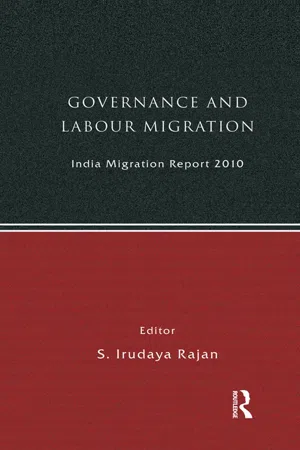
India Migration Report 2010
Governance and Labour Migration
S Irudaya Rajan, S Irudaya Rajan
- 336 páginas
- English
- ePUB (apto para móviles)
- Disponible en iOS y Android
India Migration Report 2010
Governance and Labour Migration
S Irudaya Rajan, S Irudaya Rajan
Información del libro
The first India Migration Report proposed by the Research Unit on International Migration set up by the Ministry of Overseas Indian Affairs, Government of India at the Centre for Development Studies, Thiruvananthapuram, Kerala is organised into articles on four broad themes: migration, remittances, gender, and policy issues.
The opening article reviews the historical trends in international migration, followed by two articles that deal with workers' remittances and one which discusses the maturity that Kerala emigration reached in this state. Other articles focus on cross-border migration in developing countries, and as yet less documented gender issues, including the migration of nurses and housemaids.
Though large numbers of unskilled and semi-skilled labourers migrate to the Gulf region, the prevailing labour laws and the violation of human rights in the GCC countries are an unexplored area; this is something this volume also addresses. The cost of migration and the role played by unscrupulous recruitments agents are serious concerns for both the government and international agencies working in migration. The Emigration Act 1983 provides guidelines for organising recruitment business in India. Do we have to revamp the recruitment system? These are some of the themes this book discusses.
Preguntas frecuentes
Información
1
Historical Overview of International Migration
Introduction
Pre-independence Migration
Indentured Labour from India
Índice
- Cover
- Half Title
- Title Page
- Copyright Page
- Dedication Page
- Contents
- List of Tables and Figures
- Foreword
- Preface
- Acknowledgements
- 1. Historical Overview of International Migration
- 2. Remittances, Consumption, Investment, and Economic Growth
- 3. Impact of Rupee Appreciation on Remittances
- 4. Stability in Kerala Emigration: Results from the Kerala Migration Survey 2007
- 5. Cross-Border Migration in Developing Countries
- 6. Migration and Gender Empowerment: Emerging Issues
- 7. Gender Mobility and State Response: Indian Domestic Workers in the UAE
- 8. Understanding Female Emigration: Experience of Housemaids
- 9. Student Nurses and their Migration Plans: A Kerala Case Study
- 10. Impact of Male Migration on Women’s Mobility
- 11. Migration Policy Reforms in India: Some Reflections
- 12. Looking Beyond the Emigration Act 1983: Revisiting the Recruitment Practices in India
- 13. Managing Migration from India: Lessons from the Philippines
- Notes on Contributors
- Index